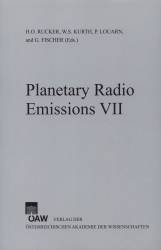
Planetary Radio Emissions VII, pp. 189-196, 2011/12/28
Proceedings of the 7th International Workshop on Planetary, Solar and Heliospheric Radio Emissions held at Graz, Austria, September 15–17, 2010

A model involving an additional contribution to Io’s ultraviolet (UV) aurora is presented. A mechanism for heating of electrons of Io’s ionospheric plasma up to sufficient energies for the excitation of Io’s atmospheric oxygen and emitting of observed UV emission is proposed. The mechanism operates by the effect of the different magnetization of the electrons and ions in Io’s ionosphere which in the course of Io’s motion through the Jovian magnetic field causes the creation of a charge-separation electric field in the upstream part of the ionosphere. This field has a component parallel to the magnetic and shifts the electron distribution function relative to the ion distribution function by a value exceeding the thermal velocity of electrons. In this case, a Bunemann instability with a very large growth rate develops. This results in the excitation of turbulent pulsations at frequency close to the ion-sound frequency and the occurrence of anomalous resistance to the electric current. The latter causes heating of Io’s ionospheric electrons up to a temperature of about 25 eV. Atmospheric oxygen molecules excited by collisions with the heated electrons of Io’s ionosphere, whose density is about 6 × 104 cm-3, can contribute to the observed UV brightness. The proposed model permits one to explain the correlation of UV brightness with Io’s magnetic longitude and the discrepancy between the anti-Jovian equatorial UV spots and sub-Jovian spots as well.